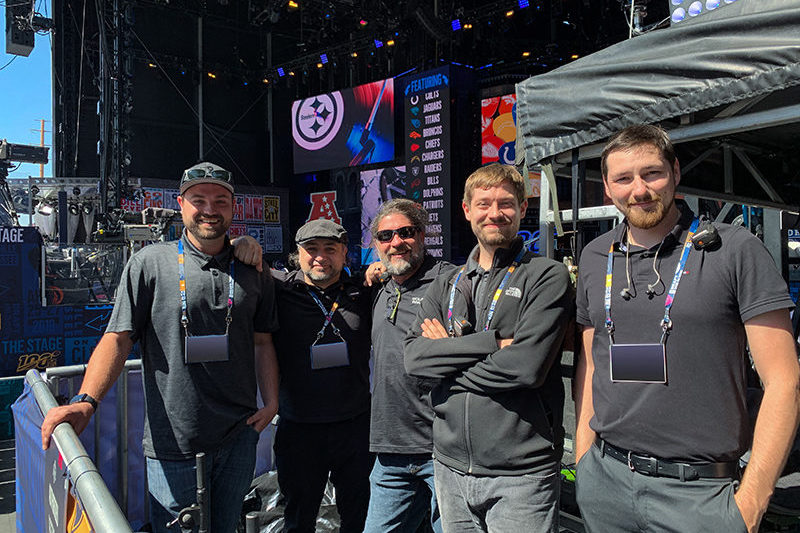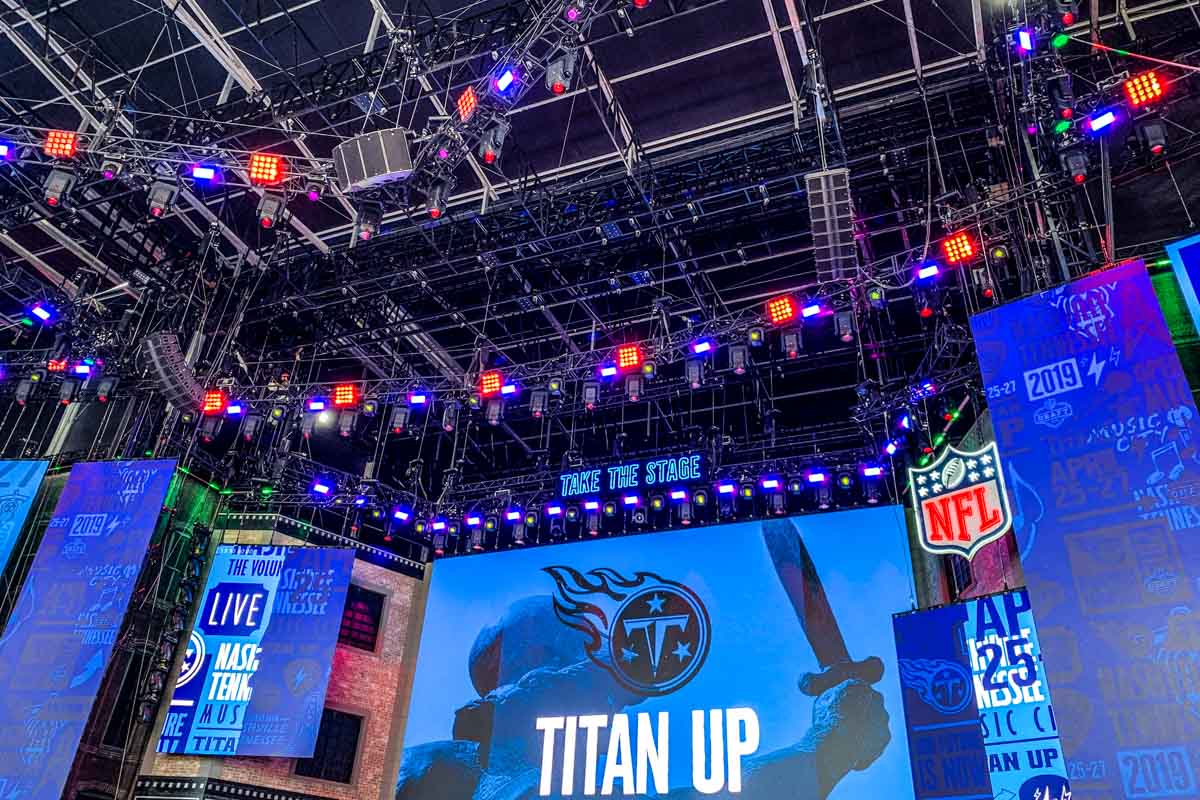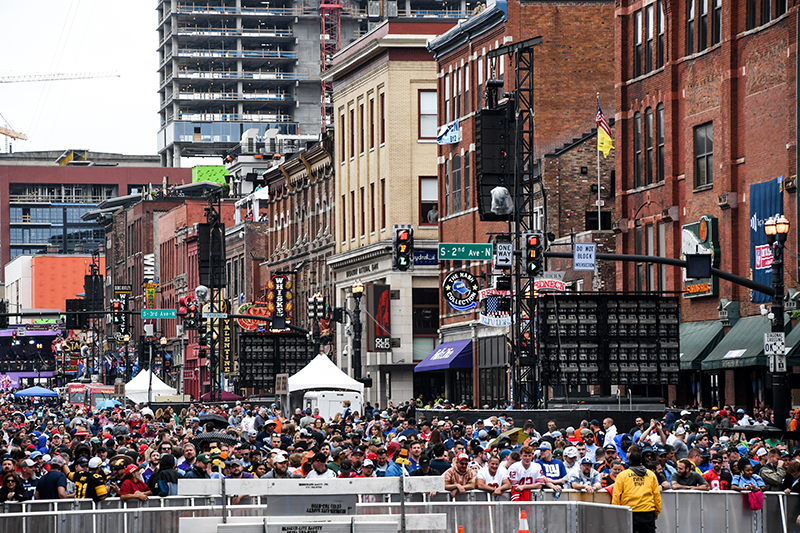Original Article: FOH Magazine and FOH Online
by Dan Daley – Created: June 18, 2019
Nashville Tackles Sports’ Biggest Live Event Ever, with Sound to Match
What happens when you put the nation’s biggest sports league’s largest live event ever into one of the most popular downtown destinations in the country?
That pretty much describes the NFL Draft, football’s annual wheel-and-deal event that used to take place in some smoke-filled league back offices, but in this century has transformed into an extravaganza that’s been topping itself year after year. Following huge parties in New York City, Philadelphia and Dallas, the 2019 edition set a record over three days in April in Nashville, where an estimated 600,000-plus people mobbed the city’s downtown honky-tonk district, easily eclipsing the 200,000 that the Dallas event drew last year and the 250,000 in Philly in 2017. The Nashville event also set broadcast records, averaging 6.1 million views on ESPN/ABC and the NFL Network.
That last statistic is relevant in a live-sound magazine, because designing a sound system that’s supposed to cover half again as many people as were at Woodstock (another three-day music festival) in an area that’s a tiny fraction of the 600 acres that show occupied is itself an engineering feat. Doing it around the mandates of global broadcasters who can dictate where you put your speakers in a city that’s become very sensitive about how it looks on TV is a whole other ballgame.
Big Sound In A Tight Space
“We were astonished at the scale of the event,” recalls Thomas Ruffner, audio operations manager at LD Systems, the SR provider for the event, which saw all 32 NFL teams bulk up their 2019-2020 season rosters while listening to live music from headliners Tim McGraw, Dierks Bentley and CeCe Winans, all working from the same massive main stage. LD Systems, which had just come off of providing live sound for the also-huge Houston Livestock Show and Rodeo and its lengthy concert schedule at NRG Stadium a month earlier (where they deployed nearly 360 L-Acoustics speakers), faced the NFL Draft’s own specific needs. These were developed with input from the NFL; concert/festival/event producer C3 Presents, which produced the live entertainment show; Van Wagner Sports & Entertainment, which did the same for the Draft’s live program; and the broadcast networks. A lot of cooks in this broth, underscored by a five-day load-in and four-day load out for all systems providers across the entire event campus.
Those specs required placement of certain speaker hangs higher than mathematically indicated, in order to keep them out of the line of sight of ESPN and NFL Network broadcast cameras and the scenic elements such as the video walls that covered the stage and that were placed throughout the event area. In addition, the sound system was going to have to address full-range high-SPL music as well as a lot of spoken-word and prerecorded content, as part of the Draft’s program, which would require high speech intelligibility. “The [broadcast and event] esthetics took priority over pretty much everything else for this show,” says Ruffner. “So we had to design the system around that.”
System Design
The sound system was divided into two main elements. An “inner circle” area within the 160-foot-wide stage structure was reserved for VIPs and those directly connected with the mechanics of the Draft, and everything/everyone else, which covered a nearly five-block-long stretch of Nashville’s Broadway main drag. It’s a ribbon of asphalt lined with an array of its own noisemakers, in the form of clubs and bars, many bearing the brands of country stars like Luke Bryan, Jason Aldean and Blake Shelton, whose own house bands spill out into the street through open street-level picture windows. They were not going to stop playing during the event, so the NFL Draft’s P.A. system needed to be, in a word, loud.
The interior area, sometimes called the theater, was covered using eight L-Acoustics Kara boxes per side line array, with six SB28 subs strategically hidden within the set and six four ARCS-II boxes in a hang as flown center fills. The larger main system consisted of 14 K2 flown per side backed by eight KS28 subs per side flown in a cardioid configuration. Beyond that, a series of three delay towers, comprising four L-Acoustic K1 boxes over four K2s, were spaced at distances approximately 250 feet apart from the main stage and each other along the north side of Broadway, with the last tower intended to throw the final 400 feet to the end of the event perimeter at Fifth Ave., backstopped at the Bridgestone
Arena. All of this was powered by 45 L-Acoustics LA-8 amplified controllers for the mains and four LA-12X amps for the subs, housed in 15 LA-Raks for the mains and two LA-Rak-IIs for the subs, for a total of what Ruffner estimated to be 350,000 watts. Possibly a bit of overkill but, as Ruffner says, “You really want some headroom at an event like this.”
There were two separate FOH positions: one, with an SSL L500 Plus, was dedicated to the Draft program mixing sound from the stage podium and its two Shure MX418/C cardioid gooseneck microphones and any prerecord. The other, an Avid Venue Profile desk, was used to mix the live music and other entertainment. A second Profile system — configured for 96 channels — managed monitors for both program needs and entertainment needs from one position, most of which were a mixture of hardwired and wireless IEMs, plus a pair of powered (and rarely used) wedges.
Strategic Coverage
Sound system coverage had to be carefully and precisely calculated in certain spots, again with the broadcast in mind. Two significant ones were the pair of eight-foot-high announcer booths for the NFL Network and ESPN, located on either side of the stage and right at the stage’s edge, on eight-foot-high platforms; both networks made specific requests to keep their locations, with their multiple, always-on broadcast mics, out of the coverage pattern. “Strategically, we had to aim those Karas without splashing on the broadcast booths,” notes Ruffner. “That’s where that ARCS center fill came in, with a narrower coverage pattern that allowed us to get to the furthest reaches of the inner circle without affecting the broadcast booths.”
The placement of the delay towers also fell under this concern, though in this case due of their potential impact on the visuals, as some of the network cameras were aimed straight down Broadway, and one of them, the famed Skycam that traverses the entire length of a gridiron on game days, running that five-block gamut from the Bridgestone to the stage.
“We had to deal with the situation as it was, and we had a lot of distance to cover, which is why the systems on the towers were rather large, more so than we might otherwise have done,” Ruffner explains. “We had to deploy a lot of horsepower to achieve the throw needed while maintaining consistent tonal balance and SPL across the entire area. We wanted to give everyone a rock ‘n’ roll experience but they also needed to be able to hear everything clearly, so they can hear their guy get picked for their team.”
Each of the delay-tower audio systems were paired with a 9 x 16-foot, 10-mm/5,000-nit LED video screen, supplied by GoVision (since then rebranded as ANC). The video signal, transported over fiber by C3 from the NFL’s NEP television trucks in the broadcast compound near the main stage, had its delay coordinated with that of LD Systems’ for the live sound. “We tested it throughout the load-in and linked it up,” explains Brady Haass, GoVision’s VP of client services. “We wanted to make sure there was a good viewing experience at every point along Broadway, and for that there has to be good sync between audio and video.” (PRG provided the LED screens on the main stage, as well as the stage lighting.)
Signal transport was a combination of analog and digital, and dusted off a name in networking that’s not heard as often as it once was. LD Systems deployed a CobraNet audio network over fiber/Cat-5 to get digital audio from the stage to the first delay tower, after which it was converted to AES audio to the rest of the delays towers, using Electro-Voice N8000 DSP processors as the interfaces. L-Acoustics’ Network Manager is run to all delay towers for system control, as well cabling for an analog backup. Ruffner says the N8000s once served as LD Systems’ primary speaker processor back when the company was mainly an E-V house, but now they are mostly used for console matrixing and signal distribution. “The N8000s with CobraNet cards are not widely used throughout the industry anymore, but it’s a protocol we’ve been using for a long time so we’re familiar and confident with it and it works well,” he says.
Wireless Express
Wireless audio was complex, as might be expected in such a tight downtown area with multiple broadcasters at work. LD Systems brought in 16 channels of Shure Axient Digital Wireless mics, with a dozen channels allocated to the NFL program and the remaining four channels for entertainment applications. Along with these 16 channels, they also supplied a complement of ADx1, ADx1M, ADx2FD transmitters all networked and remotely managed with Shure’s Spectrum Manager, Show Link Access point and Wireless Workbench software. In addition, eight channels of Shure PSM 1000 IEMs were also allocated for entertainment applications.
Loren Sherman, the RF coordinator for the NFL on the event, began looking at the project a month out, but it was only within the last week before it kicked off that he was able get most of the information he’d need to begin assigning frequencies, as the networks formulated their own plans for their shows and comms. “It was a while before we were able to get all the pieces to the puzzle we needed,” he says.
Some of the network information came in through the league’s own and relatively new online frequency-coordination portal and software. But when it came to working with the music artists, several of which brought their own wireless systems, Sherman would meet with their individual RF coordinators, often the night before their sets, as they did overnight sound checks, to get their RF plots and tell them what was available.
Sherman says he had nearly 800 frequencies for the entire show, for broadcast, live music and any other applications, such as broadcast shows coming out of music clubs like Rock Bottom and Tootsie’s. However, on a show of this scale, that doesn’t go that far. He assigned 31 channels of Shure Axient Digital (the same systems were serendipitously provided by CP Communications for the broadcast and brought by artists including Dierks Bentley and Tim McGraw) to the main stage, using Shure G10 and J8 RF blocks for IEMs as well. Having all of the wireless microphones confined to the Axient’s 470-to-608 MHz range was a big help, he says. On the other hand, the number of available frequencies was so tight that he made it a policy to not give out spares to performers ahead of their shows. As it was, from the first show on Thursday through the closing performance Saturday night, Sherman was juggling channels and frequencies between artists.
“There were times we’d end the Draft portion of the show with ESPN and NFL Network still on the air as well as the main-stage hosts introducing the upcoming band, so we could not reuse any of those frequencies from the networks [for] the [music] performances,” he explains. “It was constant juggling because we also had shows going on the other side of the river at the stadium. Also, you had ENG that could just walk in during a show. There were very few uncoordinated frequency issues, fortunately. The NFL is very good about that.”
The NFL Draft is only going to get bigger. Next year’s event is slated to take place in Las Vegas and will be the first significant event hosted by the Raiders in their new home city. But the NFL Draft also portends ever-larger, more complex live events that will combine live music, broadcasting, and other elements. If the future really is all about scale, its mantra will be, “Go big or go home.”
LD Systems Crew:
Audio Operations Manager – System Designer: Thomas Ruffner
Audio Crew Chief – Systems Engineer: Julian Gates
FOH Entertainment Mixer – FOH Program Mixer A2: Rafael Rosales
Program and Entertainment Monitor Engineer: Trevor Schumann
Systems Tech: Bryan Woodall
Delay Systems Tech: Ted Bible
Overnight Systems Tech: Bryan Schaper
C3 Presents
Production Manager: Brandon Sossamon
Theater Managers: Shawn Worlow and Jeff Goodin
Stage Manager: Casey Carter
Van Wagner Sports and Entertainment
Director of Technical Operations – Draft Project Manager: Nate McCoart




